Birds in Winter: To Feed or Not to Feed?
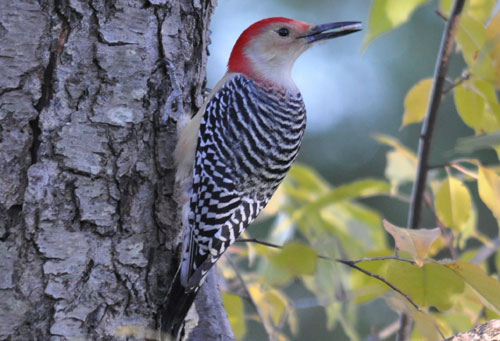
It’s an age-old question – to feed or not to feed the wild songbirds that come so willingly to our yards in the cold of winter. Some people believe that feeding wild birds can cause more harm than good and create problems for birds, such as disrupting their natural cycles, preventing timely migrations, or causing birds to depend on handouts rather than foraging for themselves. However, the truth is that these are all myths and feeding birds is actually beneficial to their survival.
In the wild, birds would normally depend on habitats that include native plants which provide seeds, nuts and berries. But every year there are fewer and fewer of these habitats left because of development and the encroachment of non-native, invasive plants. So every year, there are fewer and fewer natural sources of food for our wild birds. In addition, during cold weather, birds need to fuel up on an abundance of extra calories to stay warm. They burn off an incredible amount of energy trying to keep their body temperature up when outdoor temperatures drop. Birds will also expend a high proportion of energy searching for food. So providing supplemental food for wild birds will actually help them keep their calorie-intake high which will improve their chances to survive the brutally cold weather.
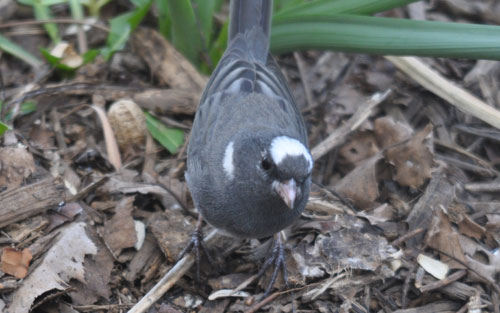
Feeding birds is helpful in another way. Birds that flock to our feeders increase OUR enjoyment as well. Stocking feeders and waiting for the feeding frenzy is a healthy past time for people. It helps to create a bond with nature, which in turn, creates a sense of stewardship for not only birds, but also for every part of nature. Without the correct habitats, the native plants, the cessation of the use of chemicals, the acceptance of other creatures; wild songbirds would simply begin to vanish, and they would die out rather quickly.
Because of these and other reasons, tens of millions of birds die each year. The American Bird Conservancy states that more than a quarter of all of our birds are on the endangered species list. This is mostly due to the loss of habitat and the loss of native plants. It is a natural progression for many people to start with one feeder in the yard, and because of the enjoyment they get from watching a few birds at that one feeder, eventually that enjoyment develops into the desire to understand and to help birds in their continued existence.
So what about the myths? First of all, birds will migrate regardless of the seeds we put in our feeders. In fact, most birds that migrate are not seed-eaters at all, but are insectivores or carnivores (such as our raptors), so the seeds in our feeders won’t tempt them to stay any way. In addition, migration is sparked by the number of daylight hours, the drop in temperatures, and the prevailing winds that help birds hitch a ride south. So feeding birds does not have an impact on those birds that migrate.
Secondly, the concern that feeding birds will cause them to depend on you for food is also a myth. Just like a bush that contains millions of seeds that birds depend on for food, eventually they will eat those seeds and that food source will no longer be available. Birds naturally know to continuously forage for themselves. They also know that they need a variety of foods in order to survive. The food that they get from you is only supplemental; and they will continue to forage for other foods so that they meet all of their nutritional requirements. If you have native plant food sources in the form of native trees, grasses, flowers and shrubs; then you will notice the birds flocking to those areas as well as your feeders. And if you run out of bird seed or stop feeding them, they will quickly go and look for other food.
However, keeping fresh seed available to birds in your feeders has many advantages. Even though birds will look for other sources of food, it does help them to conserve energy because it makes it easier for them to find the seeds in the feeders. It also helps to offset the fact that there are fewer and fewer natural sources of food every year, so more birds can get the nutrition they need. And keeping the feeders full will keep the birds coming so that you can enjoy watching them all season long.
So now that you know that feeding birds is a good thing, the next question is what to feed them. Of course, the best thing to do is to provide natural bird feeders by planting plenty of native perennials, shrubs and trees in your garden next spring. However, in the meantime, here is the scoop on the seeds that you can offer at your feeders.
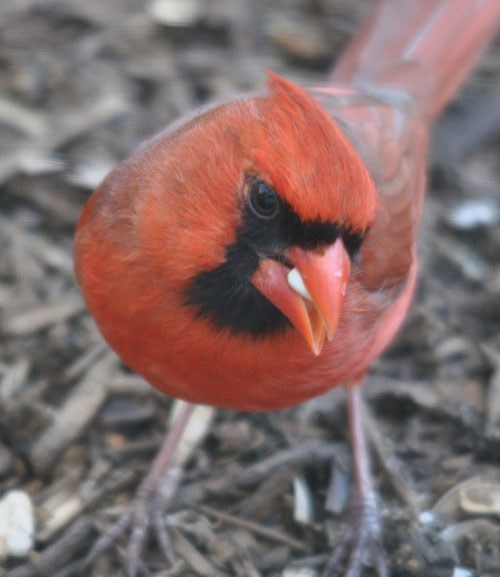
Sunflower seed:
Both black oil and striped sunflower seeds are a favorite among numerous song birds. Cardinals, titmice, chickadees, blue jays, nuthatches, house finches, gold finches, juncos, woodpeckers, all of the sparrows, towhees, doves, and black birds love sunflower seeds. In order to prevent a messy area under your feeders, you may want to consider offering hulled sunflower seeds to the birds. There is a lot less mess and a lot less wasted seed. If you could only offer one kind of seed to the birds, this would be the one.
Safflower seed
This is also a great ‘go-to’ seed for birds. Safflower is a favorite of cardinals, finches, chickadees, titmice, doves and juncos. It also has some advantages; some other ‘nuisance’ birds do not favor safflower seed. House sparrows (not to be confused with our other sparrows that are indigenous) and starlings are birds that were brought here from England. They are not indigenous and are aggressive and invasive. Although I never shoo any birds away from the feeders, I sometimes notice that these more aggressive birds take over the feeders and don’t share with our native birds. Safflower seed, although they’ll eat it, is not their favorite choice, and they tend to stay away from those feeders. Squirrels do not particularly like this seed either.
Thistle (or Nyjer) seed
If you want goldfinches at your feeders, then this seed is something you should not do without. Goldfinches absolutely love this seed and will prefer this seed over any other. There are special feeders with smaller holes to accommodate this seed. There are also special ‘sock’ feeders for thistle. All of these feeders work great. Goldfinches, since they only eat seeds, are anatomically designed to hang upside down to eat, so that when they are eating from a plant, they can continue to hold on when the flower or grass bends from the weight of the bird. In fact, goldfinches are down right comfortable with eating upside down, whereas, other birds like to sit upright. Getting an upside-down goldfinch feeder or a sock feeder means other birds will not be comfortable to use it and you can be certain the goldfinches are not being bullied away. Every couple of years, we are privileged with the presence of pine siskins, an irruptive species that comes from the forests of Canada. They, too, will flock to your thistle feeders alongside and in harmony with the goldfinches.
Nuts
By far, I have the most fun watching the birds eating the nuts. I offer shelled and unshelled peanuts for my feathered friends. Both are a big hit with downy, hairy, and red-bellied woodpeckers, chickadees, cardinals, blue jays, and titmice. I also see the dark eyed juncos muscling their way into the foray to grab a few nuts for themselves. Birds will usually grab a nut and fly away to carefully eat it at a distance, preferably in the branches of some close-by trees. It is amusing to watch the blue jays take the unshelled peanuts. There is always at least one bird who decides that taking one nut at a time is not good enough and will continuously try to figure out how to carry two nuts in his beak. It doesn’t always work and it is fun watching the bird try a few times. Although squirrels love the nuts as well, they normally do not bother the birds and often times I see squirrels and birds sitting together at feeders in complete agreement. This is probably because I offer plenty of variety of food for everyone.
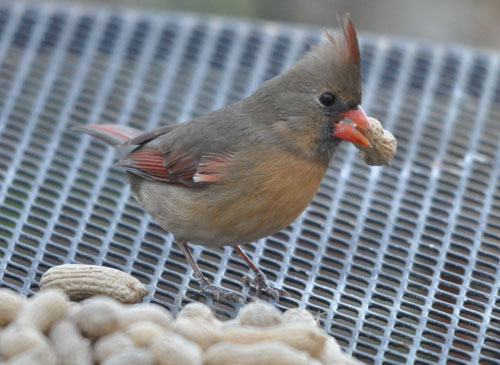
Suet
During these cold months, suet becomes an important supplemental food source for many birds. Since birds need to bulk up on calories, one easy way for them to do it is by eating suet, which is rendered fat. Lucky for them, cholesterol is not a concern. Woodpeckers, blue jays, sparrows, chickadees, titmice and others will take advantage of this nutritious treat. In addition, suet does not leave a mess under the feeder like the other seeds can.
Corn:
Cracked or whole kernel corn is a big hit with many birds. Sparrows, doves, juncos, blue jays, and cardinals love to eat cracked corn. Blue jays and bigger birds, such as grackles and crows like the whole kernels; smaller birds will eat the cracked kernels. Squirrels love corn, so if you want to keep the squirrels away from your other feeders, you can set the squirrels up with their own dining area which offers corn and nuts.
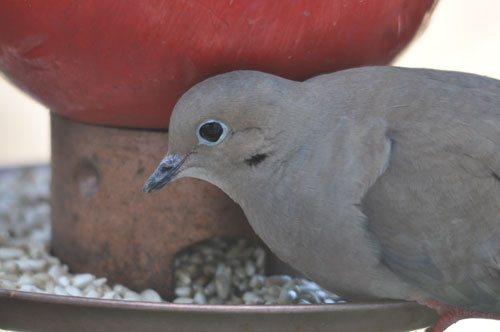
Mixes
There are many mixes of bird seed on the market today. Although you can attract many song birds to your feeders with mixes, there are a few things to consider to make sure you are getting your money’s worth. First, make sure the mix is a combination of high quality seeds, such as sunflowers, nuts, Nyjer, and safflower. The more you have of these ingredients, the better the quality of the mix. Unfortunately, a cheap bag of bird seed is usually seed that is low in quality and most of the seeds will end up being wasted and not eaten.
Seed mixes that have a high ratio of millet and milo seeds are usually not eaten by birds and may even contain other fillers, such as wheat, which is not a bird food. So even though you think you are getting a bargain, chances are you are getting a lot of rubbish instead. Opting for the more expensive mix with sunflower seeds, nuts and other goodies actually means you are getting more for your money and less waste. Some seed mixes also offer fruit, which is enjoyed by woodpeckers, mockingbirds, and even the occasional spring migrant, the grosbeak.
I prefer to offer a variety of feeders and bird foods in my yard. I started out with one feeder a decade ago, and now it has become a passion of mine with many feeders and a constant blur of a rainbow of feathers as different species of birds fly around busily visiting feeding stations and plants in my yard. Offering different foods and different types of feeders will ensure that you get to enjoy numerous visitors all season long, too. Add a thermostatic heater to keep the water from freezing in your birdbath, and you’ll have them flocking to your yard. Just remember to keep your binoculars and your field guide close at hand.
‘To feed or not to feed?’ Well, that should no longer be a question.
By Natalie Brewer, University of Maryland Extension Howard County Master Gardener
Photos by Natalie Brewer.

Agreed! I put out sunflower seed all winter simply because I love to see the cardinals in the snow.
Safflower seed is new to me though. If it has even a chance of keeping the squirrels out it’s worth a try – thanks for sharing!
Great article! Clearly and ‘fun-ly’ addressed the myths about feeding birds. Pix were perfect. Thx!
The blue jays that come for peanuts invariably pick up and put down several before flying off with one, sometimes going back to an earlier selection. I guess they’re weighing them to get the most bang for their buck (beak?).
One unintended consequence of bird seed is that it can attract mice. Make sure there are no
foundation cracks, vents or other entrance opportunities for these critters before you place
seed feeders close to your home.
What to with the squirrels who eat thebird seeds from the containers…
Tell me what to do.
Thank you
Squirrels? You can get bird feeders that are on a single pole, and the pole has a bell, pipe, or funnel shaped obstruction that attaches to the pole and prevents the squirrels from climbing to the feeder. They can climb under it but can’t get around the obstruction It’s fun to watch them trying to figure a way to go around the obstacle.